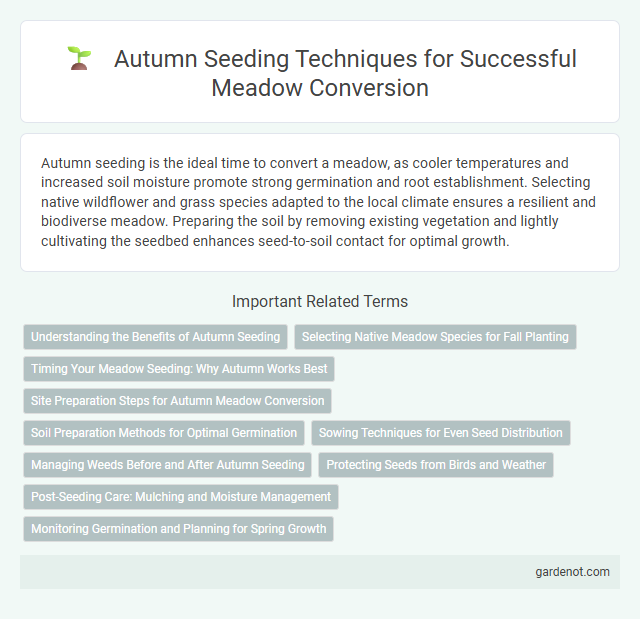Autumn seeding is the ideal time to convert a meadow, as cooler temperatures and increased soil moisture promote strong germination and root establishment. Selecting native wildflower and grass species adapted to the local climate ensures a resilient and biodiverse meadow. Preparing the soil by removing existing vegetation and lightly cultivating the seedbed enhances seed-to-soil contact for optimal growth.
Understanding the Benefits of Autumn Seeding
Autumn seeding enhances meadow conversion by leveraging cooler soil temperatures and increased moisture, promoting strong root development before winter. This timing reduces competition from summer weeds, improving seedling establishment and long-term plant diversity. Establishing a meadow in autumn leads to more resilient ecosystems and higher biodiversity in subsequent seasons.
Selecting Native Meadow Species for Fall Planting
Selecting native meadow species for autumn seeding ensures optimal establishment and growth by aligning with local climate and soil conditions. Choose cold-tolerant grasses like little bluestem (Schizachyrium scoparium) and warm-season wildflowers such as asters (Symphyotrichum spp.) that thrive with natural dormancy cycles. Incorporating diverse native species enhances ecosystem resilience, supports pollinators, and reduces maintenance requirements in meadow conversions.
Timing Your Meadow Seeding: Why Autumn Works Best
Autumn provides optimal soil temperatures and moisture levels essential for successful meadow seeding, promoting strong root development before winter dormancy. Cooler temperatures reduce competition from aggressive weeds, allowing native meadow species to establish more effectively. Seeding in autumn ensures early spring growth, maximizing plant biodiversity and ecosystem resilience.
Site Preparation Steps for Autumn Meadow Conversion
Effective site preparation for autumn meadow conversion includes thoroughly clearing the area of existing vegetation through mowing or controlled grazing to reduce competition. Soil cultivation techniques such as scarification or light tilling help improve seed-to-soil contact and enhance germination rates. Finally, soil testing and amendment ensure optimal nutrient levels, supporting healthy establishment of native meadow species during the cooler, wetter autumn months.
Soil Preparation Methods for Optimal Germination
Effective soil preparation methods for autumn seeding in meadow conversion include deep scarification to break compacted layers and enhance aeration, ensuring optimal seed-to-soil contact. Incorporating organic matter such as compost improves soil structure, moisture retention, and nutrient availability, which are critical for seed germination during cooler temperatures. Proper leveling and removal of debris prevent waterlogging and promote uniform seed distribution, leading to successful establishment of native meadow vegetation.
Sowing Techniques for Even Seed Distribution
Autumn seeding for meadow conversion requires precise sowing techniques to ensure even seed distribution, which promotes uniform germination and plant growth. Employing methods such as drilling or broadcasting combined with light raking helps achieve optimal seed-to-soil contact and reduces seed clumping. Using calibrated seed drills with adjustable settings enhances accuracy, ensuring the seed rate matches the recommended density for diverse wildflower and grass species.
Managing Weeds Before and After Autumn Seeding
Managing weeds before and after autumn seeding is crucial for successful meadow conversion, as it ensures young plants establish without competition. Employing methods such as targeted herbicide application or mechanical removal before seeding reduces weed seed banks and promotes healthy germination. Post-seeding, regular monitoring and spot-treating emerging weeds prevent invasive species from overpowering native grasses and wildflowers.
Protecting Seeds from Birds and Weather
Autumn seeding enhances meadow establishment by allowing seeds to undergo natural stratification, improving germination rates. Protect seeds from birds by using seed covers or netting, preventing loss and ensuring better soil contact. Shielding seeds from adverse weather with mulch or protective layers reduces washout and desiccation, promoting successful early growth.
Post-Seeding Care: Mulching and Moisture Management
Post-seeding care for autumn meadow conversion is crucial, with mulching playing a vital role in protecting newly sown seeds from soil erosion and temperature fluctuations. Applying a layer of organic mulch such as straw or compost helps retain soil moisture, ensuring optimal hydration during seed germination. Maintaining consistent moisture levels without waterlogging supports healthy root development and enhances seedling establishment for a robust meadow ecosystem.
Monitoring Germination and Planning for Spring Growth
Monitor germination closely during autumn seeding by checking soil moisture and temperature to ensure optimal seed sprouting. Document seedling emergence rates weekly to identify any areas requiring re-seeding or irrigation adjustments. Plan for spring growth by preparing nutrient-rich soil amendments and scheduling timely mowing to promote healthy meadow establishment.
Autumn seeding Infographic

 gardenot.com
gardenot.com